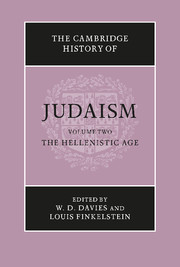Book contents
- Frontmatter
- 1 The archeology of Hellenistic Palestine
- 2 The political and social History of Palestine from Alexander to Antiochus III (333–187 B.C.E.)
- 3 Hebrew, Aramaic and Greek in the Hellenistic age
- 4 The Diaspora in the Hellenistic age
- 5 The interpenetration of Judaism and Hellenism in the pre-Maccabean period
- 6 The men of the Great Synagogue (circa 400–170 .b.c.e.)
- 7 Pharisaic leadership after the Great Synagogue (170 B.C.E.–135 C.E.)
- 8 Antiochus IV
- 9 The Hasmonean revolt and the Hasmonean dynasty
- 10 Jewish literature in Hebrew and Aramaic in the Greek era
- 11 Jewish–Greek literature of the Greek period
- 12 The Apocrypha and Pseudepigrapha of the Hellenistic period
- 13 The book of Daniel
- 14 The matrix of apocalyptic
- 15 The Septuagint and its Hebrew text
- 16 The Targumim
- 17 The Samaritans
- 18 The growth of anti-Judaism or the Greek attitude towards the Jews
- Bibliographies
- Chronological table
- Index
- References
10 - Jewish literature in Hebrew and Aramaic in the Greek era
Published online by Cambridge University Press: 28 March 2008
- Frontmatter
- 1 The archeology of Hellenistic Palestine
- 2 The political and social History of Palestine from Alexander to Antiochus III (333–187 B.C.E.)
- 3 Hebrew, Aramaic and Greek in the Hellenistic age
- 4 The Diaspora in the Hellenistic age
- 5 The interpenetration of Judaism and Hellenism in the pre-Maccabean period
- 6 The men of the Great Synagogue (circa 400–170 .b.c.e.)
- 7 Pharisaic leadership after the Great Synagogue (170 B.C.E.–135 C.E.)
- 8 Antiochus IV
- 9 The Hasmonean revolt and the Hasmonean dynasty
- 10 Jewish literature in Hebrew and Aramaic in the Greek era
- 11 Jewish–Greek literature of the Greek period
- 12 The Apocrypha and Pseudepigrapha of the Hellenistic period
- 13 The book of Daniel
- 14 The matrix of apocalyptic
- 15 The Septuagint and its Hebrew text
- 16 The Targumim
- 17 The Samaritans
- 18 The growth of anti-Judaism or the Greek attitude towards the Jews
- Bibliographies
- Chronological table
- Index
- References
Summary
The Hellenistic period begins in Palestine with the arrival of Alexander the Great in 332 b.c.e. The appearance of the Macedonian conqueror did not, however, change things overnight, and certainly not in the sphere of Jewish literature. Such literature continued to be written in Hebrew or Aramaic, though Greek influence may be detected in it here and there. The Greek language gained ground only slowly in Palestine. Palestine came to be encircled by a ring of Greek cities, for it was mainly on the edges of Jewish territory, on the coast and to the east of Jordan, that the conquering Greeks established, one by one, their settlements. Gaza, which was devastated during Alexander's conquest, must have been one of the first cities to be rebuilt on the pattern of a Hellenistic town. At Samaria, which now became Sebaste, a Macedonian garrison was established on the orders of Alexander himself. Perdiccas was the founder of the Greek city of Gerasa in the Trans Jordan. He was undoubtedly one of the first of Alexander's followers to settle a Macedonian population in Palestine. Dion and Pella were presumably founded at this same period. The object of implanting these Macedonian colonies was partly to ensure the loyalty of the local inhabitants and partly to reward the soldiers with grants of land.
But it was mainly during the century from 300–200 b.c.e., when the country was under the control of the Ptolemies, that Greek cities came to flourish in Palestine. In this period there originated Ptolemais (Akko), Philoteria on the shore of lake Tiberias, Scythopolis (Beth Shean) and Philadelphia (Amman) to name only a few.
- Type
- Chapter
- Information
- The Cambridge History of Judaism , pp. 352 - 384Publisher: Cambridge University PressPrint publication year: 1990



